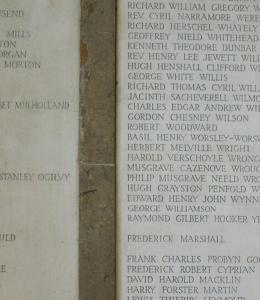Known as Jock, he was the son of Arthur Harold and Elsie Steel Lewes of Hanworth, Middlesex who married in Steyning, Sussex in 1911. His place of birth is variously given as Calcutta and Britain and has not been verified. He may have been born en route to Australia where he grew up in Sydney.
He was educated at King’s School, Parramatta and Matriculated in 1933.
He arrived in England on 25 September on the Largs Bay from Sydney and gave his address as Christ Church and his nationality as British. On coming up to Christ Church, his address was Fernside, Bowral, N.S.W. Australia. An article in the Courier Mail of Brisbane on 2 September 1933, listed the students who were on their way to England to attend various universities. His brother David was one of them. He was born in Australia in 1915.
Jock read PPE. He was President of the Oxford University Boat Club 1936–37 and rowed in the 1st Eight. David who read Physiology, was a Rowing Blue, also.
In February 1939, his seventy-year-old father and fifty-eight-year-old mother arrived at Tilbury on the Otranto, along with his sister born in 1913.
He was commissioned as a second lieutenant, University Candidate, General List in 1935. After he graduated, he transferred to a Territorial Army unit, 1st Battalion, the Tower Hamlets Rifles, Rifle Brigade before joining the Welsh Guards in 1940. He was billeted at Sandown Race Course and was appointed training officer for the regiment. The artist, Rex Whistler, a fellow officer, painted him with a gun on his knees, sitting on the steps of the grandstand.
In 1941, David Stirling gathered a small unit of volunteers, amongst whom was Jock Lewes. The required qualifications were that they had to be a parachutist; an expert with all kinds of arms; well practiced in close combat; tough enough to jump off a truck going at 30mph, able to march 100 miles with a heavy pack; and able to face any contingency and make decisions alone. The unit was named L Detachment of the Special Air Service Brigade. The main objective was to conduct raids against the lines of communication of Axis forces in the Western Desert. Fed and equipped by the secret patrols of the Long Range Desert Group, they, sometimes, remained behind enemy lines for two months at a time.
Jock Lewes was killed in action in December 1941. He was returning from a raid on German airfields when the Long Range Desert Group truck in which he was travelling, was attacked by a lone Messerschmitt 110 fighter. He was fatally wounded in the thigh by a 20mm round from the plane and bled to death. He was buried on the site where the attack happened. The whereabouts of his grave are unknown.
24th December 1941
No1 Group To destroy aircraft at Tamet airfield
Number One Group consisting of Mayne, MacDonald, White, Bennett, Hawkins, and Chesworth.
Drove to within 3 miles of airfield and destroyed 27 aircraft. Party dispersed by enemy fire but rejoined. Celebrated Christmas Day on return journey with LRDG.
No2 Group To Destroy aircraft on Nofilia airfield
Number Two Group consisting of Lewis, Almond, Lilley, Storey, White, and Warburton
Walked in from 16 miles. Aircraft dispersed and enemy alert. 1 aircraft destroyed. On return with LRDG strafed by enemy aircraft. Jock Lewis killed. White PW. 4 trucks destroyed. LRDG walked 250 miles to Gialo oasis
He was credited with inventing the Lewes Bomb, a type of IED (improvised explosive device); and was awarded the DSO.
David Stirling said of Lewes: "Jock could far more genuinely claim to be founder of the SAS than I."
He is commemorated on the Alamein Memorial. Column 53. and at King’s School, Parramatta. [132 of their old boys were killed in WW2. 101 had been killed in WW1.]
At the time of his death, he was engaged to marry Esme Mirren Barford, an Oxford undergraduate who lived at 14 Merton Street. On 18 June 1943, she married at St. Peter-in-the-East, Oxford, an American doctor, serving with the U.S. Forces. Her first son was born at Eynsham Hall, Witney in 1944. Two further sons were born in the United States. She died in 1992. In 1995, the letters between her and Jock were published “Joy Street; A Wartime Romance in Letters 1940-42”
His brother, David, served as a Squadron Leader in the RAFVR He was a tutor in medicine at Hammersmith postgraduate medical school, and then a consultant at Bedford General Hospital. He died on 22 April 1997.
Sources include: http://www.sasspecialairservice.com/john-steel-lewes.html
Foreword and Appendix to Joy Street, A Wartime Romance in Letters, edited by Michael T. Wise, published in 1995 by Little, Brown and Co (ISBN 0 31694767 9)
A History of the SAS
"Jock Lewes: Co-founder of the SAS" J.Lewes (2000)


